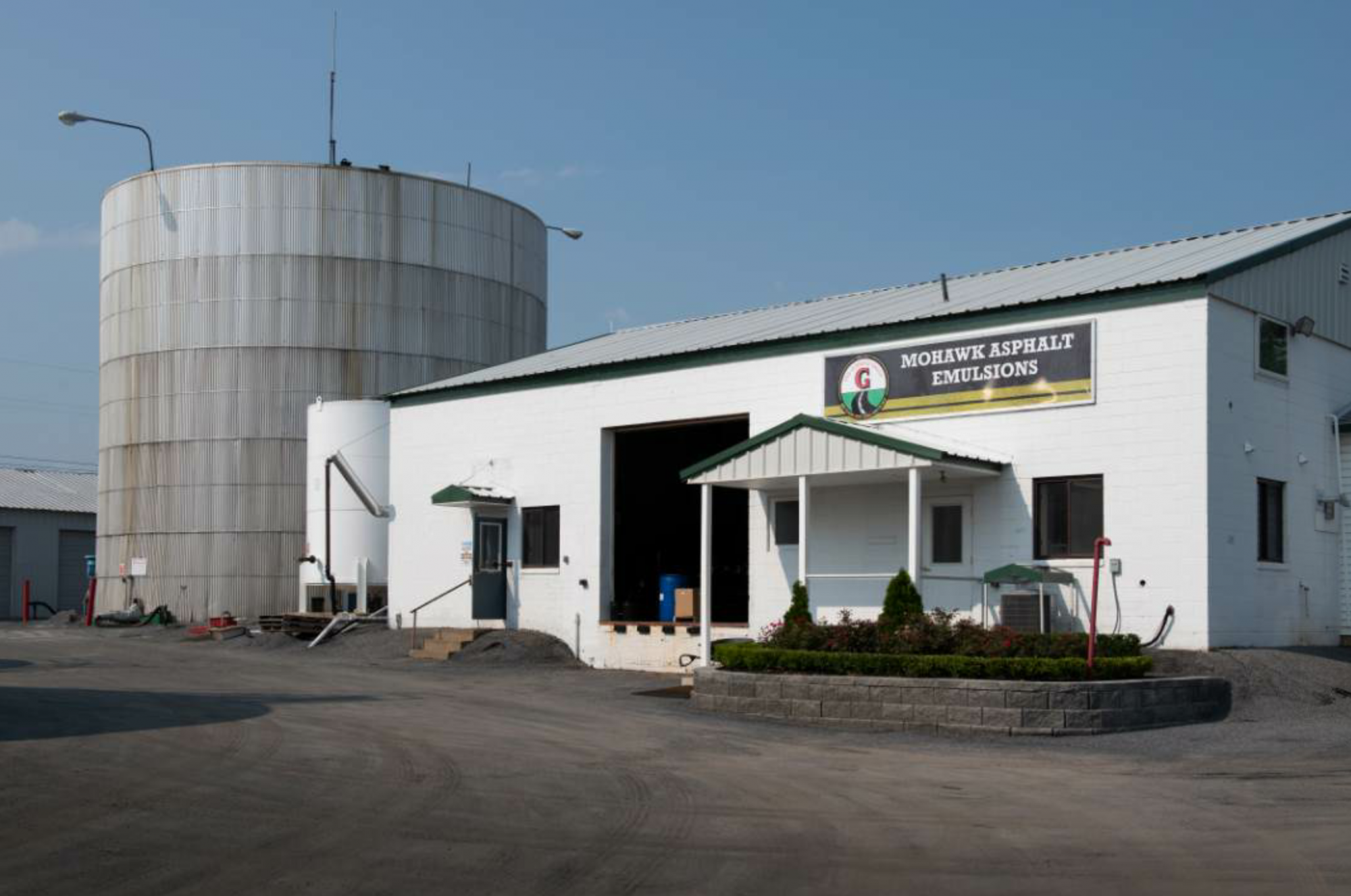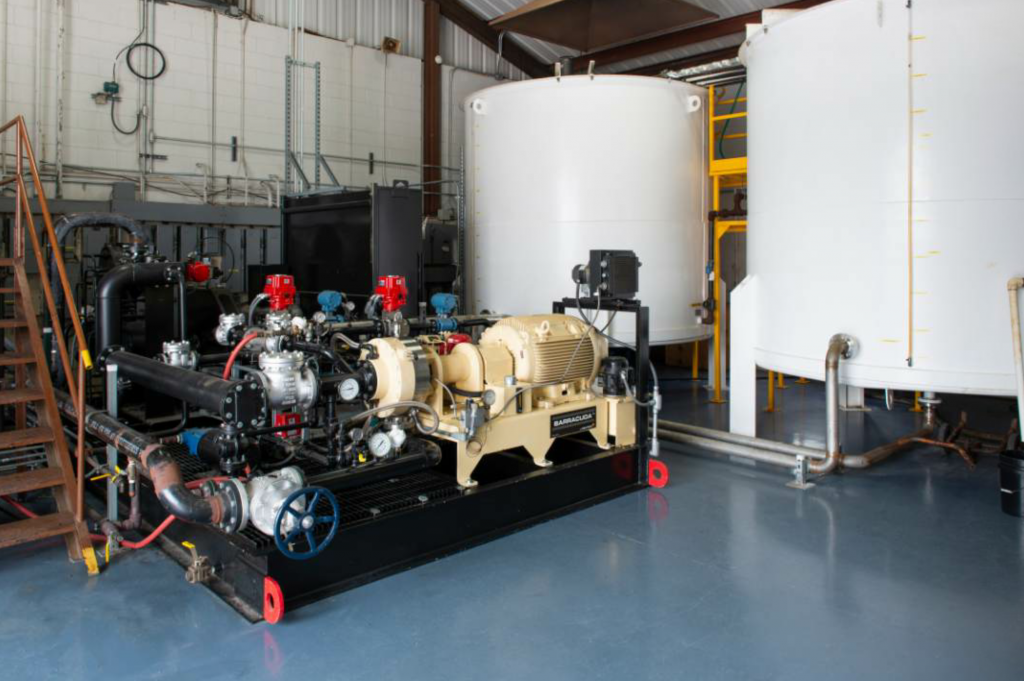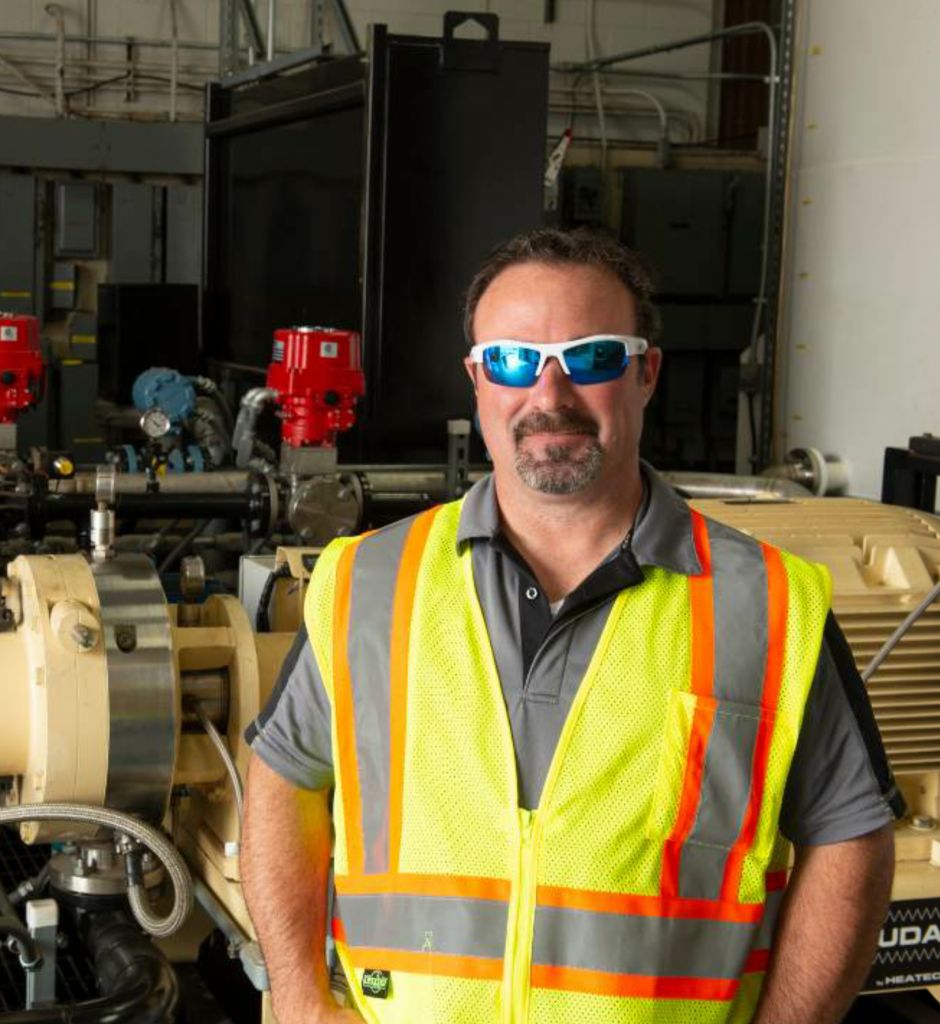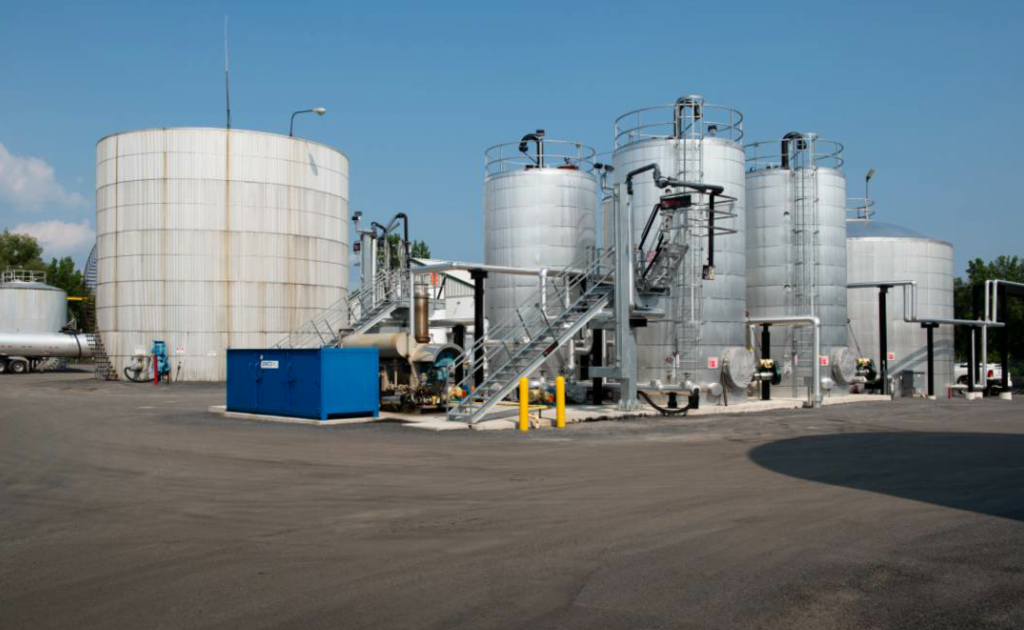Gorman Group Makes Asphalt Emulsions Easier
BY John Flynn

The Gorman Group improves its emulsion production with a Heatec Inc. Barracuda emulsion mill skid.
Due to sub-optimal system performance, 2017 was a “tumultuous year” for making asphalt emulsions. That’s the way Brian Jones described it. He’s the technical services director for The Gorman Group, headquartered in the Northeast. The problem wasn’t lack of demand. It was a milling system that didn’t perform as needed.
“We had a tremendous amount of issues [that] year with our old mill,” Jones said. “You can’t even make up half the stuff that happened to us…with our old mill. Even with those types of issues happening we had zero support. It got to the point where we’re tearing apart the mill to replace bearings and having to drive down to pick up the replacements. So it was a very tumultuous year. We were running around 18, 20 hours a day to keep up with our construction group. Most of the time it was hand-to-mouth. We were making it and they were taking it. We were just barely keeping up, which is not good. Emulsions really like to be made and set in the tank for a night to mature and digest. And we just weren’t able to do that.”

The Barracuda emulsion mill skid is installed in the mill room at The Gorman Group.
Lab Manager Tim Roser added, “We had a lot of issues with the previous mill. And that was the same type of mill that we had run here since 1975. It was the same model. We’d had a total of four mills over the course of that time. On the last one nothing seemed to go right and it had a lot of issues with mechanical things breaking down. That system was a lot more manual. Almost all the valves had to be manually turned open or closed for soap solution, asphalt, solvent, latex, or anything.”
Founded in 1917, The Gorman Group is a highway construction company that covers the Northeast, primarily New York, Vermont, Connecticut, Massachusetts, New Hampshire, Maine and Pennsylvania. They serve towns, counties, municipalities and states like the New Hampshire Department of Transportation.
“My grandfather and my father helped to build Mohawk Asphalt Emulsions [Mohawk Asphalt Emulsions was purchased by The Gorman Group in 1985] and in 1975 we made our first gallon of emulsion,” Jones said. “I’m third generation at this company. My father still works here part time and I’m here now so I’ve got black running through my veins.”
With their long history and experience in this industry, Jones and his team unsurprisingly took a savvy approach to find the best solution for what they needed in a new milling system. “I did some extensive research on mills before we went to purchase our next,” Jones said. “I did a matrix of all the different mills that are out there. I compared the pluses and minuses to all the different mills and did a cost analysis on all the different features each one had to offer.” Some of the features The Gorman Group looked for in a new milling system included semi-automation, versatility, quality and support. Jones and company think they have found what they were looking for in the Barracuda™ emulsion mill skid from Heatec.
“When we started looking, we saw different types of mills and the different types of automation available. We liked how it was easier for the mill operators because everything is controlled from a central control panel and much more automated,” Jones said.
The Gorman Group makes around 30 different recipes of asphalt emulsion, so it was important for the system to be versatile. “We took into consideration the types of emulsion we make and the production levels the mills were capable of.” Jones said.

Brian Jones is the technical services director for The Gorman Group.
Because they make so many recipes, they have to be able to switch back and forth. A semi-automated system makes switching between recipes much easier. Jones explained, “It’s all on demand. We try to stay with cationic, if we’re making the cationic emulsions, and make as much as we need. But if we are required to flop over, we’ve got a really good system in order to transfer. It really takes very little time, the transfer, it’s semi-automated. It’s a flushing procedure that we go through. We flush the mill out, we flush the tanks out. And we go. We don’t flop back and forth if possible, but if we have to, we do.”
“This year, we’ve actually been able to make a couple of emulsions that in the past few years we haven’t been able to make because of the old system’s limitations,” Roser said. “That mill was not capable of making certain blends with the combination of the mill plus the asphalt chemicals. This year, we’re able to make it with no problems.”
“We also looked at where the mill was manufactured. There are other mills out there, but the fact that a lot of the parts are made in Europe kind of was a drawback to us,” Jones explained. “We really like the fact that Heatec products are American-made in Chattanooga, Tennessee. If we need parts, I can have them by 9 a.m. tomorrow morning….They’ve got a lot of sister companies that have experience in the construction world and they understand the sense of urgency.”
“Right from the start, it was not a customer/supplier relationship,” Jones said. “It was a partnership type of relationship. Everything that we asked for, within reason, they were able to do. And I think they were learning from us and we were learning from them what the unit can do. So it was never a customer/supplier relationship. I think, right from the start, it started off as a as a partnership, which is good.”
Jones specifically mentioned Drew Bryson, Josh Patterson and John Gage from Heatec as being instrumental in the design and support for their new system. Bryson, construction project designer, and his team worked closely with Jones to design the system to meet the needs of The Gorman Group. Patterson, a PLC programmer, custom designed the computer controls for their system. Both Patterson and Gage, a service technician, were onsite during startup and didn’t leave until Jones and his team felt comfortable running the unit on their own.

Some of the storage tanks at the plant
The support continued after they got up and running. Jones said, “Josh can be anywhere in the country, and he can dial in and see what’s going on in my mill and do troubleshooting from there. And that’s huge. I can’t tell you, we’ve used him at least two or three times with programming issues or things we wanted to change, and he doesn’t have to be here. I’m on the phone with him and he’s in Chattanooga logging into the system saying ‘yep, I see what you’re talking about, I’m going to make this change.’”
In addition to support, the quality of The Gorman Group’s new mill has provided significant changes to production and productivity.
“This mill’s production levels have reduced our hours of operation,” Roser states. “With the old system, you always had to run 18 to 20 hours a day in order to keep up. [2017] was even worse than that. So with the new mill, compared to [2017], we’re almost—not quite—double the production. You don’t have to have somebody here running the thing 20 hours a day. We can keep up or stay ahead with the mill only running 12 hours versus 18 to 20. That’s a big improvement. You don’t have to have somebody here and you’re not fighting with things all the time. It’s a much, much smoother operation too. It’s easier on the guys running it versus the old system. Plus we were always up against it trying to keep the tank levels up. And it seems like this year with this system it’s much, much easier for us to keep product in the tank and keep enough so that we’re ahead of the crews more than we ever were before.
“I know some other companies don’t make as many varieties of emulsions; we make 28 or 29 kinds of emulsion here. So we’re constantly going back and forth and changing formulas and everything. The guys that are running it seem to be much happier with this system. Changing back and forth formulas, putting formulas in. And to be honest, we really haven’t had to tweak our formulas as much as we did in the past because of the inconsistencies that we were experiencing. Now it’s more of a consistent product. You don’t have to keep changing this and that up and down.”
With the new mill in place the future looks bright for The Gorman Group. Brian Jones sees the emulsion business growing.
“I think more and more towns, counties and the public are starting to understand the value of pavement preservation. So I see emulsion sales growing year to year.
“We’re a member of AEMA, which is the Asphalt Emulsion Manufacturers Association. Their goal is to double the emulsion sales by 2020 as an organization and they’re working to educate people. They’re working to teach the public and the folks that are making the decisions on road repairs that it doesn’t always make sense to go worst first. Let’s protect the good roads so they last longer. You spend a lot less to protect the good road than you do to have a complete rebuild. I think that education is going to help grow emulsion sales.
“We’re starting to see more interest in what we do. We’re doing research and development on different types of emulsions and we’re trying to develop our emulsions to make them better. If it’s more polymer or polymerizing certain emulsions that haven’t been polymerized, we’re working on that. We’re working on new materials that use emulsion. So, we as a business, we see some very good potential for growth on the emulsion side. The last three years or so we have been fairly stagnant, give or take a few hundred thousand gallons, but this year I see a significant uptick in demand for emulsion.”
“I think the expectation was to have something that was easier for everybody to run and that makes a better product,” Roser said. “We’ve met the expectations that I had. Increased production, less man hours. I think those were the expectations. To make life easier for everybody. And it seems to have accomplished that.”
